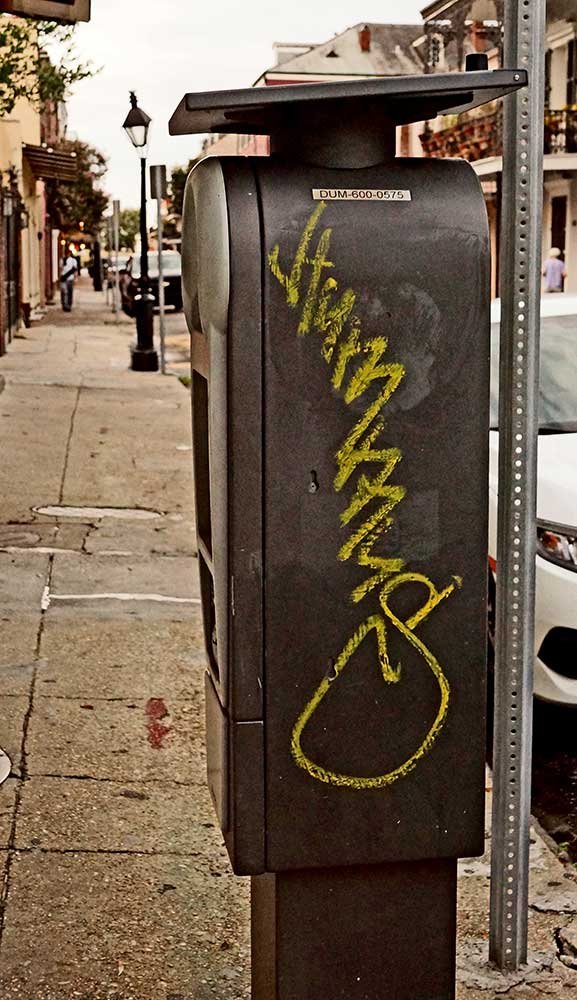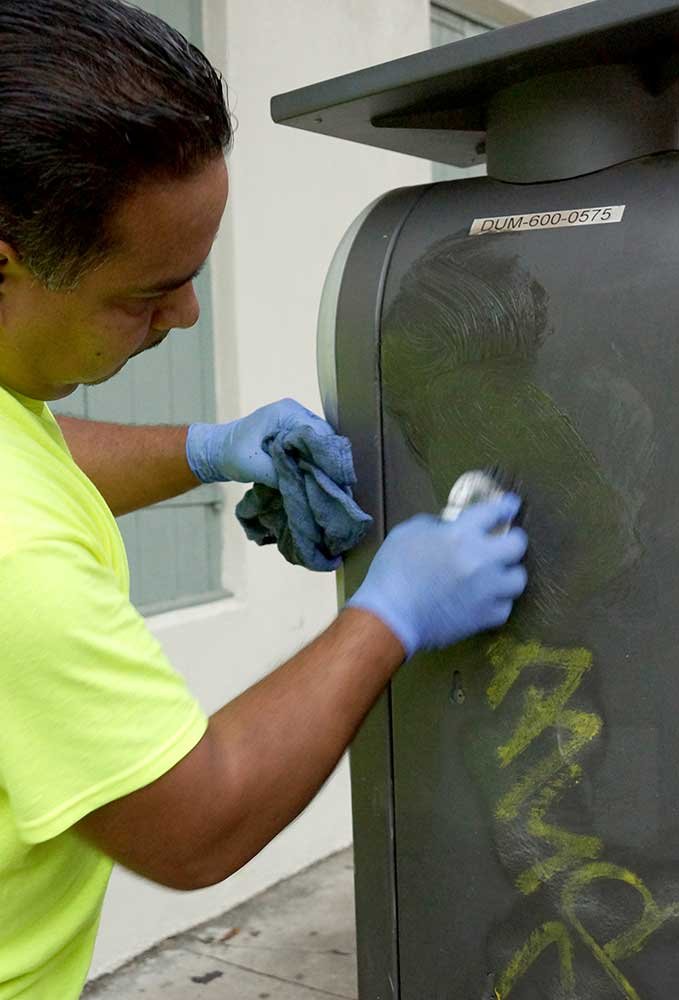The Sticky Business of Carlos Buesos
Long before first light, this eradicator of property defacement begins his hunt through the Quarter, determined to scour graffiti and stickers from public property.
- by Dar Wolnik
- photos by Ellis Anderson
For reasons understood by most New Orleans residents, the French Quarter enjoys services that are unique to its role as a city that hosts about 12 million annual visitors. For instance, the Quarter has daily trash removal and street cleaning.
Since 2015, the facility services company Empire Services has been the provider in the Quarter for mechanical street-sweeping, sidewalk pressure-washing and has staff assigned to walking litter patrol called “pan and broom services.”
Two Empire staffers cover the graffiti removal circuit seven days a week: Carlos Bueso and his weekend counterpart, Lawrence Jackson. Bueso works Monday through Friday, 4 a.m. to 1 p.m., removing graffiti and stickers from any and all city property: trash cans, drain covers, street signs, bike racks, cell phone towers and benches.
While tourists are sleeping off the night before and the Quarter is quiet, Bueso begins his day by picking up the golf cart that holds his ladder, his cleaning supplies and 35 gallons of water for rinsing. He refills the tank three or four times a day, sometimes more.
“I don’t stop too much,” he says.
The French Quarter Business Association (FQBA), along with other prominent French Quarter groups implemented the Vieux Carre Graffiti Abatement Program (VC-GAP) in the summer of 2010. VCGAP hosts volunteer graffiti cleanups and sends courtesy notifications to French Quarter property owners whose properties have been vandalized.
For its part, Empire would like to make that initiative obsolete.
Project Coordinator Jennifer Garin says, “Our hope is that the Vieux Carré associations don't have to continue to have (graffiti removal) events because there would be no graffiti for them to remove. That way they can focus their resources on other items that need attention in our French Quarter.”
Tags
Once, while Bueso was cleaning a graffiti tag from a trash receptacle, a man confided that it was his handiwork, then even allowed a picture with his face and his tag.
“He was proud of what he did!” Bueso says, amazed.
Historians have long noted the impulse for travelers to leave graffiti behind. In his book “Pagan Holiday: On the Trail of Ancient Roman Tourists,” author Tony Perrottet traced the routes and tags left behind those long-ago travelers, and notes that some were even known to hire professional stone cutters to leave their mark.
The graffiti is not particularly inspired in the Quarter, usually consisting of scribbled “tags” hurriedly placed on city trash cans or, shockingly, on centuries-old brick walls - all of which require some patience and proper tools to remove.
The tags are almost always a scribbled word, or name and tend to show up in multiple places. The legibility of the writing does not seem important; the shape and style being recognizable seems the priority.
The tags are placed using a paint pen and most often done with white paint - although fluorescent green or blue are favorites as well. Empire is constantly tinkering with its removal strategies, currently using up to three solvents and many scraping techniques.
Stickers
Stickers more than tags are the “Moby Dick” for any removal squad in the French Quarter. They are as diverse as the people who leave them: band stickers, business advertisements (oddly, often from outside of the area), website addresses, skateboard shops, protest stickers (which increase in number right after a march or an election), and always a few of those conventioneers’ “Hello My Name is” lapel name-tags.
Most numerous however, are the stickers for French Quarter walking tours. Those ubiquitous tour group stickers come in every color and type font, depending on the tour and vendor. The tours use them to identify who has paid for the tour in order to weed out those “freeloaders” who sidle up to listen to the spiels or use the lapel stickers to more easily corral their group to the bus.
Unfortunately, as soon as the tours end, usually somewhere in the middle of the Quarter, stickers are often quickly “disposed” of by the attendees on the sides of garbage cans, on gallery poles, on gutter downspouts, street signs and even affixed to the windows of homes or businesses.
Bueso noted the effort some people take to put those stickers in difficult-to-reach spots. Halfway down Ursuline Street he points out one wrapped around a cell phone antenna at least eight feet off the ground. At five feet, six inches tall, he will have to use ingeniuity, and his ladder and his cart to remove it.
Bueso drives around to prioritize trouble spots, but always spends the earliest morning hours in Jackson Square before it fills with people and buskers.
The streets from Decatur to the riverside of North Rampart are next, with bustling Bourbon Street requiring at least two rounds each shift.
Bueso and his coworkers also check the “hundreds streets,” which Empire staff call the streets from Iberville to Esplanade (as they have addresses 500-1000). But since they're more residential, they don't have the same problem with graffiti or stickers as the more commercial areas.
As Bueso works, he takes "before" and "after" pictures, immediately emailing those and any pictures of broken infrastructure to Garin, who forwards them to the proper agencies.
The morning we were riding with Buesos to take photographs, at 6am, he discovered something he'd never encountered before.
This collage piece had actually been screwed to the traffic sign.
Nice sentiment, wrong venue.
The entire Empire team stays in constant contact by radio and email. Supervisors are on the streets, conferring with staff throughout the shift. Bueso’s radio crackles constantly with street name call-outs and he must stay alert to the back-and-forth as he can be called to assist with a large trash-removal project at any time.
Residents and workers help by letting him know about trouble spots; in return, he has been known to wash a soiled sidewalk if something appeared overnight and the person is unable to hose it off themselves. Most people are nice, he says, thank him regularly, and even offer to tip him although the staff cannot accept gratuities.
Bueso also keeps in contact with the Quarter’s hotel and business custodial staffs who do their best to keep up with the same issues on their private properties as Empire shoulders for the city. Each alerts the other to problems when spotted.
Bueso is pleased with the progress. “I can already see a huge difference in the Quarter since we began.”
You Have to Take On More...
Bueso moved to the United States from Honduras when he was nine years old, living at first with his parents in Portland, Ore., and later Miami, Florida. His parents eventually returned to Honduras. Bueso's fiancée, Marina - who is also Honduran - has a brother in New Orleans so they moved here and then married. The couple have two children - a 13-year-old daughter and a 7-year-old son.
Marina cleans houses all across New Orleans. Upon arriving in the city, Bueso first got a job working at the Kenner riverboat casino. Then, Marina noticed an Empire job posting for custodial work at area schools and businesses. He applied and was hired. After a few years, he asked to be transferred to a day-shift role and became Empire’s graffiti remover in 2018.
The family lives in Jefferson Parish in an area with a large concentration of Spanish-speaking people. He had never even been in the French Quarter until he started to work for Empire.
Since then, Bueso has brought his wife and his daughter to visit the Quarter. They did like the French Market flea market area and he recommends that to his neighbors who ask where to go in the Quarter. The diversity of sellers and wares there are very familiar to Hondurans, Bueso says.
He hopes soon to be trained to drive one of the mechanical sweepers that snakes through the Quarter early in the day. Even when he is able to do that job, Bueso wants to remain as the main graffiti guy.
“It is a lot of responsibility, but that is what you have to do in this life. Take on more.”
Help support our creative team –become a member of our Readers’ Circle now!











